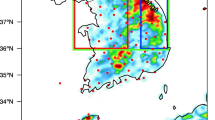Abstract
This study examines the variability of the monthly average significant wave height (SWH) field in the Mediterranean Sea, in the period 1958–2001. The analysed data are provided by simulations carried out using the WAM model (WAMDI group, 1988) forced by the wind fields of the ERA-40 (ECMWF Re-Analysis). Comparison with buoy observations, satellite data, and simulations forced by higher resolution wind fields shows that, though results underestimate the actual SWH, they provide a reliable representation of its real space and time variability. Principal component analysis (PCA) shows that the annual cycle is characterised by two main empirical orthogonal functions (EOF) patterns. Most inter-monthly variability is associated with the first EOF, whose positive/negative phase is due to the action of Mistral/Etesian wind regimes. The second EOF is related to the action of southerly winds (Libeccio and Sirocco). The annual cycle presents two main seasons, winter and summer characterised, the first, by the prevalence of eastwards and southeastwards propagating waves all over the basin, and the second, by high southwards propagating waves in the Aegean Sea and Levantin Basin. Spring and fall are transitional seasons, characterised by northwards and northeastwards propagating waves, associated to an intense meridional atmospheric circulation, and by attenuation and amplification, respectively, of the action of Mistral. These wave field variability patterns are associated with consistent sea level pressure (SLP) and surface wind field structures. The intensity of the SWH field shows large inter-annual and inter-decadal variability and a statistically significant decreasing trend of mean winter values. The winter average SWH is anti-correlated with the winter NAO (North Atlantic Oscillation) index, which shows a correspondingly increasing trend. During summer, a minor component of the wave field inter-annual variability (associated to the second EOF) presents a statistically significant correlation with the Indian Monsoon reflecting its influence on the meridional Mediterranean circulation. However, the SLP patterns associated with the SWH inter-annual variability reveal structures different from NAO and Monsoon circulation. In fact, wave field variability is conditioned by regional storminess in combination with the effect of fetch. The latter is likely to be the most important. Therefore, the inter-annual variability of the mean SWH is associated to SLP patterns, which present their most intense features above or close to Mediterranean region, where they are most effective for wave generation.


















Similar content being viewed by others
Notes
The meteorological observations used in the model cannot, however, be homogeneous during such a long period
The NAO index here used is obtained from PCA of 1,000 gph ERA-40 geopotential field; the correlation with the index computed in Jones et al. (1997) is 0.83.
References
Buzzi A, Tibaldi S (1978) Cyclogenesis on the lee of Alps: a case study. Quart J Roy Meteorol Soc 104:171–287
Cavaleri L, Bertotti L (2004) Accuracy of modelled wind and waves fields in enclosed seas. Tellus 56(2):167
Cavaleri L, Bertotti L, Lionello P (1991) Wind-wave cast in the Mediterranean sea. J Geophys Res 96C:10739–10764
Günter H, Rosenthal W, Stawarz M, Carretero JC, Gomez M, Lozano I, Serano O, Reistad M (1998) The wave climate of the Northeast Atlantic over the period 1955–94: the WASA wave hindcast. Global Atmos Ocean System 6:121–163
Hoskins BJ, Hodges KI (2002) New perspectives on the Northern Hemisphere winter storm track. J Atmos Sci 59:1041–1061
Hurrell JW (1995) Decadal trends in the North Atlantic Oscillation: regional temperatures and precipitation. Science 269:676–679
Jones PD, Jonsson T, Wheeler D (1997) Extension to the North Atlantic Oscillation using early instrumental pressure observations from Gibraltar and South-West Iceland. Int J Climatol 17:1433–1450
Kripalani RH, Kulkarni A (2001) Monsoon rainfall variations and teleconnections over south and east Asia. Int J Climatol 21:603–616
Lionello P, Elvini E, Nizzero A (2003) Ocean waves and storm surges in the Adriatic Sea: inter-comparison between the present and doubled CO2 climate scenarios. Clim Res 23:217–231
Simmons AJ (1991) Development of the operational 31-level T213 version of the ECMWF forecast model. ECMWF Newslett 56:3–13
Simmons AJ, Gibson JK (2000) The ERA-40 project plan, ERA-40 project report series n.1
Trigo IF, Bigg GR, Davies TD (2002) Climatology of cyclogenesis mechanisms in the Mediterranean. Mon Wea Rev 130:549–649
Von Storch H, Zwiers FW (1999) Statistical analysis in climate research. Cambridge University Press, Cambridge
WAMDI group, Hasselmann S, Hasselmann K, Bauer E, Janssen PAEM, Komen G, Bertotti L, Lionello P, Guillaume A, Cardone VC, Greenwood JA, Reistad M, Zambresky L, Ewing JA (1988) The WAM model—a third generation ocean wave prediction model. J Phys Oceanogr 18:1776–1810
Acknowledgements
The RON observations dataset has been provided by the APAT agency (Agenzia per la Protezione dell’Ambiente e servizi Tecnici, environmental protection agency and technical services). Data are available at http://www.telemisura.it. Figure 11 and results of linear regression analysis, shown in Table 3, were obtained using the Graphpad Prism software, version 4.00 for Windows, San Diego, California USA, demo available at http://www.graphpad.com. Time series of Indian Monsoon observed data have been downloaded from the Indian Institute of tropical Meteorology web site, http://www.tropmet.res.in.
Author information
Authors and Affiliations
Corresponding author
Rights and permissions
About this article
Cite this article
Lionello, P., Sanna, A. Mediterranean wave climate variability and its links with NAO and Indian Monsoon. Climate Dynamics 25, 611–623 (2005). https://doi.org/10.1007/s00382-005-0025-4
Received:
Accepted:
Published:
Issue Date:
DOI: https://doi.org/10.1007/s00382-005-0025-4




